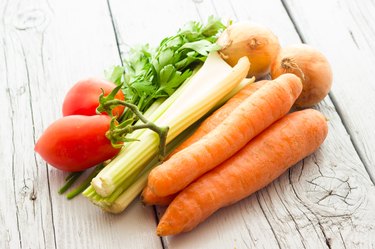
Cellulose is a thick, strong fiber that that gives vegetables and fruits their structural integrity. It is one type of dietary fiber that can be eaten but is not digested. Many fruits and vegetables are rich sources of cellulose. Interestingly, cellulose in the form of wood pulp is sometimes added to processed foods to increase their fiber content, according to business news website The Street.
Cellulose Overview
Video of the Day
Cellulose and other types of fiber are components of plants that the human body cannot break down and absorb. When eaten, cellulose passes through the gastrointestinal tract relatively intact. It is insoluble, meaning it does not dissolve in water.
Video of the Day
Benefits
Cellulose encourages movement of food through the intestines, thus helping to prevent constipation and irregularity. There is also evidence to suggest a correlation between a high-cellulose diet and a low risk of colon cancer. The exact mechanism for this benefit is not fully understood. Cellulose is also touted to play a role in weight loss by increasing the feeling of satiety and is featured in commercially available supplements. However, a study published in the medical journal "Obesity" found that a weight-loss supplement containing cellulose had no effect on appetite.
Dietary Sources
All plant foods, such as fruits, vegetables, grains, beans, nuts and seeds contain cellulose. Whole foods, with the skin and seeds intact, have more cellulose than foods that have these removed. While juices do contain types of dietary fiber, they do not provide any cellulose.
Recommended Intake
Women 50 and younger should get 25 g of total fiber daily, while men the same ages require 38 g, according to the Mayo Clinic. Women who are 51 and older need slightly less -- 21 g daily -- while men 51 and older should get 30 g daily. There are no specific recommendations for cellulose, but it should be included in your total fiber intake.
Use in Processed Foods
The cellulose you get in processed foods advertised as high-fiber might come from an unexpected source. The Street website reports that wood pulp is commonly added to processed foods as a filler. Foods that contain cellulose in this form include syrup, pancake mixes, frozen waffles, ice cream bars and sandwiches and frozen breakfast meals.
- The Street; 15 Food Companies That Serve You 'Wood'; Miriam Reimer; March 2011
- MayoClinic.com; Dietary Fiber: Essential for a Healthy Diet; Mayo Clinic Staff
- Elmhurst College: Cellulose
- "Obesity"; Effect of a Cellulose-containing Weight-loss Supplement on Gastric Emptying and Sensory Functions; Heiner K. Berthold, et. al; April 2008
- Colorado State University Extension; Dietary Fiber